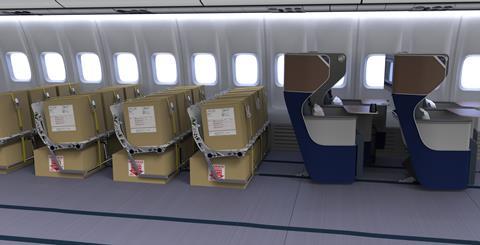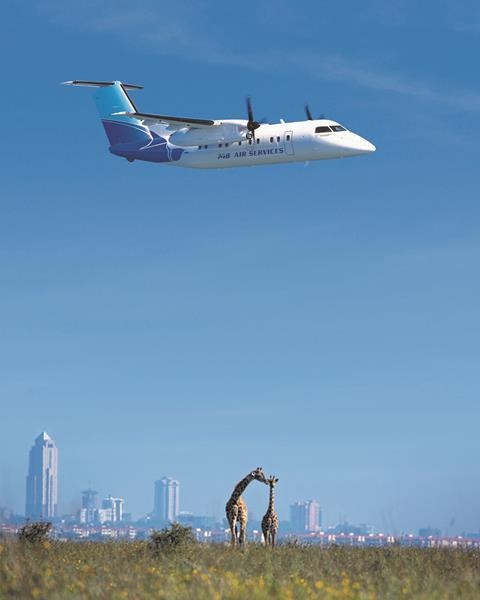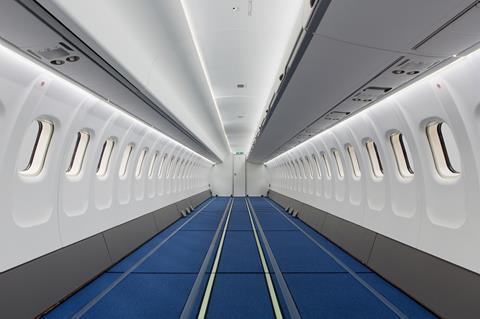One of the strangest sights of the coronavirus crisis has been airliners jetting into near-deserted airports, their cabins brimming with cardboard boxes secured with netting, either atop seats or stacked on the floor of a stripped out interior. While lockdowns and travel restrictions have starved the skies of passengers, air cargo demand – particularly for personal protective equipment (PPE) manufactured in Asia and desperately needed in Europe and North America – has been racing ahead of capacity.

That is not because more goods are moving around the world. In fact, the global economic slowdown prompted by the pandemic saw air freight volume plunge by almost 28% year on year in April, according to IATA. About half of all air freight normally travels as belly cargo on passenger aircraft, and the sharp reduction in flights has seen forwarders scrambling to transport urgent consignments – not just of PPE and other medical items, but also goods crucial to just-in-time global supply chains. The collapse of airline networks means there simply are not enough aircraft to shift the items consumers, businesses and governments need.
For many airlines, with their cash reserves dwindling from a lack of passenger revenue, freight has been a godsend. Emirates chief executive Tim Clark admitted earlier this month that the critical need for cargo capacity was helping prevent a financial disaster for the Dubai-based airline after it halted all but a handful of its passenger flights. “We’ve converted ourselves to a mini UPS,” he says, with 85 of Emirates’ Boeing 777-300ERs operating as stand-in freighters, in addition to its 11 777Fs.
Virgin Atlantic says it has increased its cargo-only flights by more than one-third to nearly 600 during June, after breaking its record for freight carried in May. The troubled UK airline has been introducing daily services to Brussels and Beijing from London Heathrow, as well as thrice-weekly flights to Atlanta, Chicago and Mumbai. “While the impact of the Covid-19 pandemic continues to restrict passenger flying, our cargo operation has never been more important both to our business and in keeping vital global supply chains running,” says chief executive Shai Weiss.

Finnair was one of the first European airlines to add to its cargo capacity by removing economy-class seats from the cabin of two of its Airbus A330s, doubling available space, according to the Helsinki-based carrier. The conversion is fairly straightforward, taking less than two days at its in-house technical services arm, explains Mikko Tainio, managing director of Finnair Cargo, with business-class seats, bulkheads, lavatories, galleys, and overhead bins remaining in place and netting secured to the seat tracks. When passenger traffic demand increases, the aircraft can be easily returned to passenger operations, he says.
REPURPOSED
Finnair has also each day during the crisis been using at least five and as many as eight of its 15 A350s on dedicated cargo flights to Asian cities including Bangkok, Beijing, Guangzhou, Hong Kong, Incheon, Osaka, Shanghai and Tokyo, as well as Brussels, Dublin, Tallinn and New York. On the larger widebodies, the seats have not been taken out, but this is an option Finnair is considering, says Tainio. As with Clark at Emirates, he says that this quick adjustment to a new business model has helped the world recover from the impact of the pandemic, and “we’ve been able to keep more of our planes in the sky and people employed”.

Icelandair also removed seats from aircraft to turn them into instant freighters, this time with Boeing 767-300s. In April it reconfigured three of the widebodies to operate cargo services between Shanghai and Munich and from Shanghai to Chicago, via Reykjavik. Swiss adapted its fourth 777-300ER in May, removing seats for cargo-only flights to destinations including Hong Kong, Mumbai, New York and Shenzhen. Before the crisis, the Lufthansa subsidiary was only offering freight services as belly cargo.
British Airways is one of the latest airlines to dispense with seating to increase capacity, using two grounded 777-200s. The carrier began operating cargo-only flights on passenger aircraft in March, initially with cargo on seats. However, it says that clearing the interior will free a further 100cb m (3,530cb ft) on the Boeing twinjets. British Airways says that, together with its sister organisation, IAG Cargo, it had by late May operated more than 80 cargo charter flights, mainly carrying PPE and ventilators for the UK National Health Service.

Many of these services were made possible by updated guidelines from the European Union Aviation Safety Agency (EASA) and other authorities to exempt airlines from the normal limits on transporting critical cargo in passenger cabins during the coronavirus crisis. One of the main changes is that crew members are able to monitor the cabin in the absence of the required smoke detectors and fire suppression equipment. However, the EASA exemptions are only for eight months. Beyond that, any change from passenger to cargo use will require a supplemental type certificate (STC).
Several MRO houses have been anticipating that requirement by working on STCs for a longer-term conversion to cargo. They include the US arm of Hong Kong-headquartered HAECO, which has come up with a concept that could see the revival of the “combi”, allowing airlines to combine passenger and cargo in the main cabin. Greensboro, North Carolina-based HAECO Americas says its STC is applicable for any widebody or narrowbody aircraft. The company has already sold it to one unnamed customer and is in “advanced talks” with three others, says vice-president marketing and strategy David Kelly.
Combis have been largely out of fashion for decades, with Air France-KLM at the outbreak of the coronavirus crisis bringing forward by a year the retirement of KLM’s five Boeing 747-400Ms – one of the few surviving combi fleets – along with the rest of the Netherlands-based airline’s jumbos. Since then, however, two of the combis have been granted a reprieve to operate cargo-only flights to China. The 747-400M, which has been in service with KLM since 1989, has a capacity for 268 passengers, with a locked bulkhead on the main deck separating the cargo area from the forward passenger cabin.
SHARED SPACE
HAECO’s solution does not involve creating a partition between cargo and passengers, however. Instead, they share the cabin. One option involves removing the seat backs and bases but retaining the seat frame as a restraint for the cargo, which is then secured with netting attached to the seat track. Another option leaves the seats intact, with a further choice to remove them completely. The company says it can complete the conversions itself or issue an instruction manual as part of the STC for customers to carry out in house.
Kelly says that, while demand for air cargo continues to outpace capacity, as passenger flights resume and the urgent need for PPE and medical equipment declines, airlines will be increasingly looking at how to use their aircraft more efficiently. “Because we are offering an STC rather than a temporary exclusion, this is something you could do permanently,” he says. Why would airlines look to do this now? “Load factors have been so high in recent years, there has not really been the need. But the economics could look very different as we come out of this, and this gives airlines flexibility,” he says.
As 2020 began, one year on from Airbus’s decision to axe production of the world’s largest airliner on the back of a dwindling orderbook, who might have predicted a second life for the A380 as a freighter? Back in the early 2000s, Airbus launched a cargo-only version of the superjumbo, with FedEx lined up to take first delivery of the A380F in 2008. However, while the variant never made it to production, one forecast made at the time might now come to pass. The US parcel giant suggested that 2020 would see passenger-to-freighter (P2F) conversions of older A380s arrive on the market.
Lufthansa Technik has completed a temporary cargo conversion of an A380 for an unnamed customer under the EASA eight-month exception. The project includes removing seating from both decks, although the lower passenger deck is able to carry more cargo. While not a true P2F, Henning Jochmann, aircraft modification base maintenance senior director, says an STC is possible by July or August, after consultations with EASA. He believes that the A380 has potential as a freighter. “At the moment the oil price is very good, and there are logistical limitations, but I expect to see more A380s on the market,” he says.
The German MRO says it has had interest from more than 40 airlines in its technical and engineering services for temporary operational changes from passenger to cargo aircraft, with “more than 15 projects for different aircraft types” in progress during May. Jochmann says the company is working “flat out” to obtain STCs for a range of aircraft, stressing that conversions involve “much more than just taking out seats…You need engineering experts who know exactly what the challenges are and how to document the technical solutions correctly so the aviation authorities agree”.
Airbus has launched its own modification scheme to convert A330s, A340s and A350s into auxiliary freighters by removing economy seats and fitting pallets onto the seat tracks, with the benefit, says the manufacturer, that it will remove from the customer the headache of securing regulatory approvals with EASA. The modification involves bringing PKC pallets, each capable of holding 260kg (573lb), through the passenger doors and attaching them to seat tracks. About 30 pallets can be installed on an A350, or 28 on an A330.
The coronavirus crisis has, of course, seen a spike in demand for medical equipment, but national lockdowns have also boosted e-commerce as consumers turn from shopping in high streets and malls to online, accelerating a two-decade-long trend. This has prompted some to suggest that, despite a looming recession, demand for purpose-built freighter aircraft could remain strong even after many of these auxiliary cargo aircraft return to passenger service.
Alex Krutz, managing director at consulting firm Patriot Industrial Partners, proposes that the US government considers a scheme to convert Boeing 737NGs into freighters, through aerostructures specialist Spirit AeroSystems. It would, he says, address demand for cargo aircraft and support both companies, as well as domestic airlines saddled with surplus aircraft. A public-private partnership, backed by private equity, would allow the government to purchase the 737s from airlines, as long as they were replacing them with newer Max aircraft, and sell them on to cargo carriers or federal agencies, he says.
The two main manufacturers of turboprop passenger aircraft are also pushing their own freighter conversions. De Havilland Canada is offering what it calls “simplified” packages for the in-production Dash 8-400, as well as legacy -100/200 and -300 variants, having secured approval from Transport Canada in May. Kenyan operator 748 Air Services will be the first to convert its four Dash 8-100s and has also ordered conversion kits for three Dash 8-400s. Canada’s Jazz Aviation was the launch customer for the -400 conversion.
The programme involves removing seats and seat track covers and can be done overnight, says chief operating officer Todd Young. “The freight market has always been interesting to us, but with the Covid situation we decided to come to market with a simplified freighter. Our product line is focused on regional cargo, and that’s where the volume and higher-frequency flights are needed. The advantage of our aircraft is that they can also go into remote areas,” he says.
Young notes that the start-up is also looking at offering a P2F conversion of the Dash 8-400 with a larger cargo door and is in “active discussions with the market”. The age profile of the fleet – the Dash 8-400 went into service in the early 2000s as the Bombardier Q400 – means it now makes economic sense for many to move into a “second life” as dedicated freighters, he says. “However, we would want a launch customer to go down that path.”
Rival ATR is also offering an instant conversion programme for its 42 and 72 variants, to help get back into service some of the inactive aircraft, which account for just over half of the almost 1,300-strong global fleet. Guillaume Huertas, head of leasing, asset management and freighters, says the Airbus- and Leonardo-owned airframer began work on the conversion as the pandemic struck in March and it was ready within a month. The Toulouse-based manufacturer developed the STC, which involves removing seats and securing shipments with nets attached to the seat tracks, with external suppliers AKKA Technologies and PMV Engineering.
ATR began offering a P2F conversion around 20 years ago and there are about 130 “full freighters” in service, just under 20 of which have been retrofitted with a larger cargo door. It also offers a combi version of its ATR 72 with 44 passenger seats and the first seven rows removed to create space for four containers, doubling the freight capacity of a conventional ATR 72. Huertas says in a freighter configuration, the turboprops often offer a much more cost-effective solution than a narrowbody on a thin passenger route, and also have the advantage of being able to access smaller and more remote airfields.

Making a pitch for any increase in demand for smaller freighters from a booming e-commerce sector will be Textron Aviation, which embarked on a flight-test programme for its new Cessna SkyCourier in mid-May, despite the challenge of lockdowns. The Pratt & Whitney Canada PT6A-powered twin utility turboprop offers a 2,220kg payload in freighter configuration, and comes with a large cargo door and flat cabin floor able to handle three LD3 containers. In 2017, FedEx signed up as launch customer with an order for 50 examples, and options for 50 more.
It remains to be seen how long the shortfall in cargo capacity will last beyond the current crisis peak, when many states were caught woefully short of the supplies of the PPE needed for health, care and other key workers, which is almost exclusively manufactured in Asia. Passenger flights are slowly resuming and that will mean more belly capacity. That, coupled with a slowdown in global trade generally as a result of the economic carnage caused by lockdowns could mean many of the quick-fire freighter conversions could arrive on the market just when demand is levelling off.
On the other hand, the only way seems to be up for e-commerce, with consumers demanding a quicker journey from factory to doorstep than many supply chains – catering for delivering large consignments of inventory to bricks-and-mortar retail networks – are geared up for. And combi configurations might find favour with airlines nervous about relaunching routes with aircraft that are too large before sufficient passenger demand returns. For some passengers, sharing an economy cabin with consignments of freight might be something they have to get used to in the coming months and years.